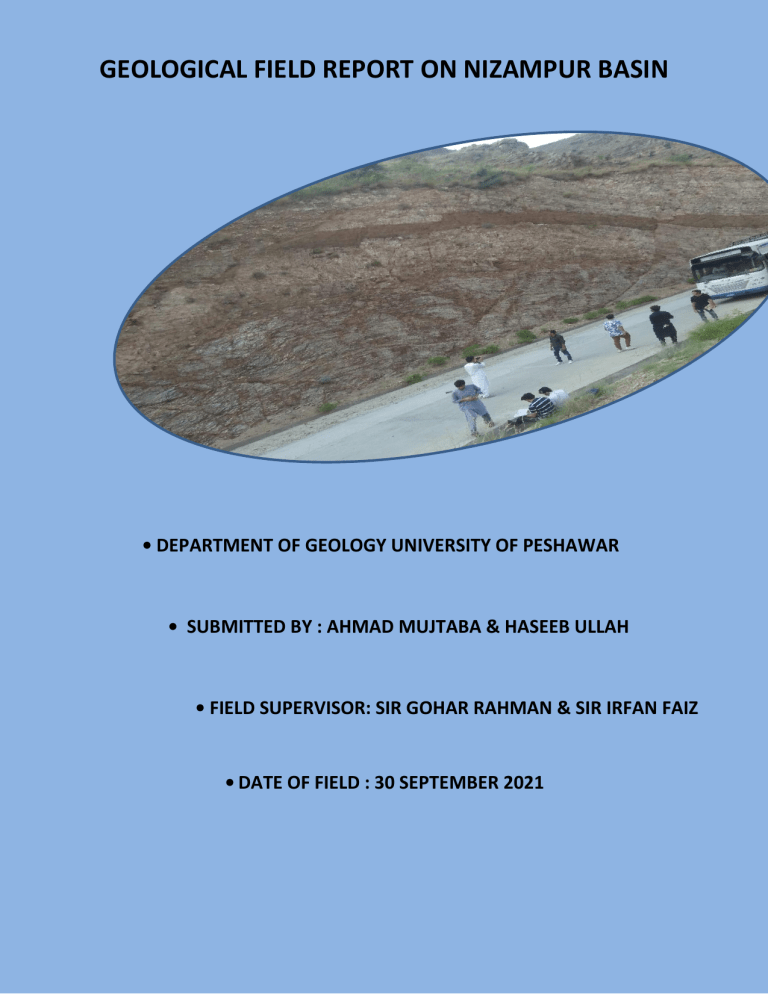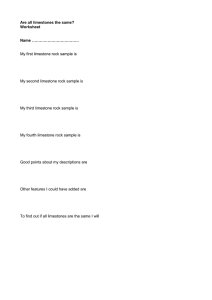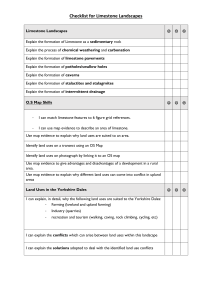
GEOLOGICAL FIELD REPORT ON NIZAMPUR BASIN • DEPARTMENT OF GEOLOGY UNIVERSITY OF PESHAWAR • SUBMITTED BY : AHMAD MUJTABA & HASEEB ULLAH • FIELD SUPERVISOR: SIR GOHAR RAHMAN & SIR IRFAN FAIZ • DATE OF FIELD : 30 SEPTEMBER 2021 ACKNOWLEDGEMENT First of all pay my deepest thanks to Almighty Allah who enabled me to complete this field work report successfully. I am greatly thankfull to Department of Geology and Mr. Gohar Rehman Sir and Mr. Irfan Faiz sir for their guidance and help us to understand field area. ABSTRACT The study area Nizampur basin. It is basically located in Punjab province of Pakistan. From Geological and Structural prospective this area got so much importance. It contain rocks with age from Jurassic (Samna Suk formation) to recent Eocene rock (Marghala Hill Limestone) This area consist of different formations like Margalla hill limestone, Patala formation, Lockhart limestone, Hangu formation, Kawaghar formation, Lumshiwal formation, Chichalli formation and Samana suk formation. Nizampur is known for its excellent exposures and structural deformation which consist of different folds and some of the minor faults for example very clear syncline are observed at stop 1 and some other fault like fault between kawaghar and Samana Suk formation also observed. LOCATION OF NIZAMPUR BASIN Attock-cherat N Range S Kala chitta and Attock-cherat meeting Nizampur basin Kala chitta range Indus river Stratigraphy of Studied Area S.no 1 2 3 4 Formation Margalla hill limestone Patala formation Lochart formation Kawagarh formation Age Eocene Paleocene Paleocene Cretaceous Fault 5 6 7 Samana suk formation Lumshiwal formation Chichali formation Jurassic Cretaceous Cretaceous Fault 8 9 10 Samana suk formation Lumshiwal formation Chichali formation Jurassic Cretaceous Cretaceous STATION 1 MARGALLA HILL LIMESTONE WITH SYNCLINE ANTICLINE FOLDING Lithology: Thin beded limestone with minor clays. Fossils: Foraminifera . Age: Due to forams it dated back to Eocene . Contact: Lower contact with patala shale at base soft and highly deform. Structural Analysis: On top of Margalla hill limestone we took amount of dipping and dipping direction with help of compass. Data are ploted on steronet bellow in picture.we also saw there a tight syncline and anticline. syncline is clear but anticline is eroded cross section of syncline and anticline below in picture.and over all lithology is jointed. (syncline and eroded Anticline in Margalla Hill Limestone) Station 2: KAHI GORGE Cross section of kahi gorge in which strata showing faults. ( Now we move from younger sequence to older sequence in Kahi Gorge) Lockhart Limestone Lithology: Thick bedded limestone , nodular 4-8 cm , dark grey color ,it give sulpury smell aftering hamering. Age: Age of lochart formation is Paleocene. Contact: lower contact of Lockhart formation is with Hangu formation . Diagnostic feature: it give sulfury smell after hamering Hangu Formation Lithology: Hangu formation mostly consist of basal latherite,shale and upper unit consist of arenaceous limestone and coarse sandstone over all color is grey to redish . Age: Age of hangu formation dated back to Paleocene. Contact: Upper contact is with Lochart formation Lower contact of hangu formation is with kawagarh formation. Kawagarh Formation Lithology: Mostly consist of marl(greenish) with interbedded clays. Age: Age of kawagarh formation is late Cretaceous Contact: In Nizampur basin lower contact of kawagarh is with samana suk formation which is faulted contact because omission of lumshiwal and chichalai formation . Here saman suk formation thrusted over kawagarh formation. Note: Whenever you see omission of stratigraphic unit so this is criteria for Fault . Kawagarh and samana suk contact Samana suk Formation Lithology: This formation consist of mostly thick to medium bedded limestone , limestone is oolitic. Age: Age of this formation is Jurassic. Contact: Lower contact of samana suk is with chichali formation. ( Olliitic limestone of samana suk formation) Chichali Formation Lithology: Chichali formation consist of mostly glauconitic sand stone and clay over all lithology give dark green color. Fossils: Belemnites Age: Age of this formation dated back to cretaceous . Contact: Lower contact is with Lumshiwal formation. Lumshiwal formation Lithology: Lumshiwal formation mostly consist of medium to thick bedded sandstone over all lithology give brown color ,burrow motling are common in Lumshiwal formation. Age: Lumshiwal formation dated back to cretaceous. Contact: Lower contact with samana suk ( here samana suk again thrusted over lumshiwal and chichali and lumshiwal again exposed) Note: Whenever you see repetition of stratigraphic unit so this is criteria for Fault . (Burrow molting in Lumshiwal formation) Samana suk Formation Lithology: This formation consist of mostly thick to medium bedded limestone , limestone is oolitic. Age: Age of this formation is Jurassic. Contact: Lower contact of samana suk is with chichali formation Chichali Formation Lithology: Chichali formation consist of mostly glauconitic sand stone and clay over all lithology give dark green color. Fossils: Belemnites Age: Age of this formation dated back to cretaceous . Contact: Lower contact is with Lumshiwal formation. 3rd Station 3rd station of our field was unknown formation but there in thrust fault some minor normal fault take place which is geologically wonder for us picture are following bellow: Conclusion Nizampur basin lie to the north of Kala chitta ranges and south of Attock cherrat range. Our first station was margalla hill limestone where we took amount and direction of dip also we saw syncline and eroded anticline. Then we move toward our 2nd station which was the Kahi Gorge there we move from younger sequence to older sequence lochart formation then Hangu formation then Kawagarh formation then unexpectedly we saw samana suk formation with omission of lumshiwal and chichali formation so here we conclude that there is thrust fault then after samana suk there expose chichali formation then lumshiwal formation then again samana suk with repition of chichali so here we conclude that we cross fault then after kahi gorge we move to unknown formation there we saw thrust fault which is full of minor normal faults which is geologically wonder for us. Refrence • hints given by sir Gohar rehman •book stratigraphy of Pakistan by Ibrahim shah •some hints taken from Google




